
- Home
- Brand
- Certification
- Country
- Manufacturer
- Theme
- Type
- Action Figure (64)
- Armor (29)
- Badge (14)
- Boot (27)
- Carburetor (196)
- Complete Carburetor (27)
- Complete Carburettor (33)
- Helmet (23)
- Jacket (19)
- Manifold (14)
- Medal (15)
- Military -- Aviation (15)
- Model Kit (12)
- Rc Tank (40)
- Tactical Vest (18)
- Tank (45)
- Throttle Body (47)
- Twin Carburetors (44)
- Twin Carburetors Kit (37)
- Wristwatch (53)
- Other (3319)
1966 Official MILIRTARY BOOK Hebrew IDF INSIGNIA Flags BADGES Ranks PINS Israel
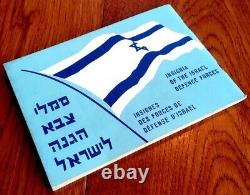
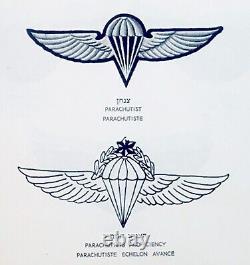

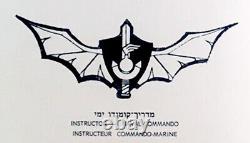
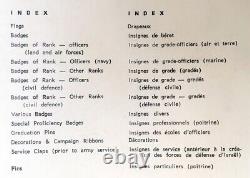
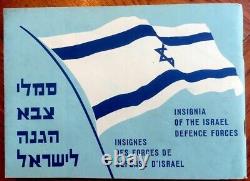
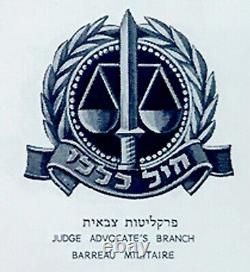

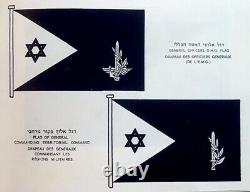

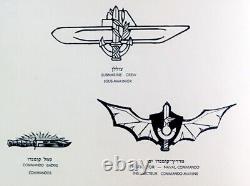

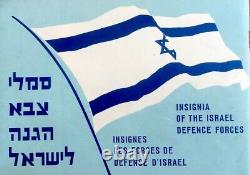


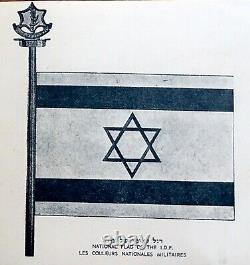

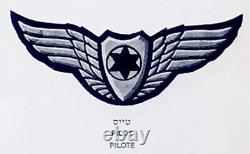

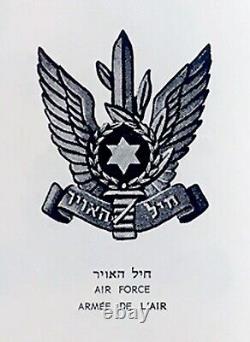

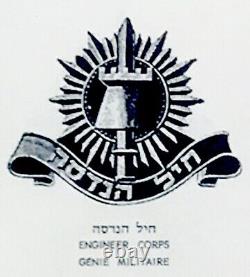

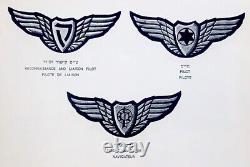


It was published 55 years ago in 1966, A year prior to the SIX DAYS WAR and printed by the MILITARY PRESS 665. An ILLUSTRATED PRUFUSION of all the IDF INSIGNIA at the time : BADGES, EMBLEMS, RANKS, FLAGS, DECORATIONS, PINS, TAGS etc. INDEX and captures in ENGLISH, FRENCH and HEBREW.
64 Throughout illustrated upaged pp. (Pls look at scan for accurate AS IS images). Will be sent inside a protective rigid packaging. AUTHENTICITY : This is an ORIGINAL 1966 (dated) Hebrew Israeli book , NOT a reproduction or a reprint , It holds a life long GUARANTEE for its AUTHENTICITY and ORIGINALITY.
Book will be sent inside a protective packaging. Officially the State of Israel Hebrew.
Israel Defense Forces insignia From Wikipedia, the free encyclopedia Jump to navigation Jump to search show This article may be expanded with text translated from the corresponding article in Hebrew. This page details the uniforms and insignia of the Israel Defense Forces, excluding rank insignia. For ranks, see Israel Defense Forces ranks and insignia. Contents 1 Uniforms 2 Berets 3 Beret pins 4 Shoulder tags 4.1 Commands 4.2 Branches 4.3 Corps 5 Insignia 6 References 7 External links 8 Bibliography Uniforms[edit] IDF uniform colors The Israel Defense Forces has several types of uniforms: Service dress (Madei Aleph)[1] - "Class A" uniform; everyday wear, worn by enlisted soldiers.
Field dress (Madei Bet)[2] - "Class B" uniform; worn into combat, training, work on base. Officers service dress / Ceremonial dress (Madei Keva) - "Class A" uniform; worn by non-commissioned officers, by commissioned officers from the rank seren (Captain) and above or by other ranks during special events/ceremonies. [3], Dress uniform (Madei Srad) and Mess dress (Madei Gala) - Worn only during very important ceremonies and abroad by high ranking officers.
[4] There are several dress uniforms depending on the season and the branch. Dress uniforms follow the American model and Mess Dress uniforms follow the British and Commonwealth pattern. The service uniform for all ground forces personnel is olive green, navy and air force uniforms are beige. The uniforms consist of a shirt, trousers, beret neatly placed under epaulet, belt and boots.
Additionally a bomber jacket and sometimes a sweater are issued to optionally be worn during cold weather. Sailors are additionally issued all-white dress uniform for ceremonies. Field dress consist of olive green fatigues, the same uniform is used for winter and summer, and heavy winter gear is issued as needed.Women's dress parallels the men's but a woman may choose to substitute a skirt for the trousers, or sandals for boots. NCOs and Officers with the rank of Captain or above wear different dress uniforms depending on the branch. Ground forces wear light teal shirts and dark green pants, in the Air Force light blue shirts and navy blue pants, and in the Navy white shirts and navy blue pants. Depending on position Officers with the rank of Captain and above may additionally substitute their boots for oxford dress shoes.
Some corps or units have small variations in their uniforms - for instance, military policemen wear a white belt and white police hat. Similarly, while most IDF soldiers are issued black leather boots, some units issue reddish-brown leather boots for historical reasons- The Paratroopers, Nahal and Kfir brigades, as well as the Border Protection Infantry and some SF units Sayeret Matkal, Oketz, Duvdevan, Maglan, Lotar (Counter-Terror School). Additionally, certain special operations units are issued canvas hiking boots for wear during missions.
Berets[edit] Soldiers of the Combat Engineering Corps being awarded with Grey berets Each corps in the Israel Defense Forces has a beret of a different color and/or a different beret pin worn by its soldiers, independent of rank and position. Israel Defense Forces soldiers wear berets on their heads only on formal occasions, such as ceremonies and roll calls.The beret is placed beneath the left shoulder strap while wearing the service uniform (alef), but not while wearing the combat/work (bet) uniform in the field. On base it is left to the unit's discretion whether to wear berets or field hats. Air force and navy officers, military orchestra soldiers and military police law enforcement soldiers wear combination caps. Formerly, male soldiers of all ranks wore combination caps, while female soldiers wore the garrison cap. In the 1950s, the beret was adopted as the default headgear for the service uniform.
The color of the air force beret was blue-gray; armored corps, artillery, and special operations personnel wore a black beret. Paratroopers, following the pattern of the British Army, wore maroon, all other infantry wore olive drab. Combat engineers wore a gray beret. For all other army personnel, except combat units, the beret for men was green and for women, black. Women in the navy wore a black beret with gold insignia while men wore the traditional white sailor cap like that of the US Navy.
IDF soldier from the Golani Brigade, in service dress a S. C, medic, with the 2006 Lebanon war ribbon & Regional Command-tier citation Corps Color Air Force Air Force Infantry Corps Golani Brigade Paratroopers Brigade and SF units Nahal Brigade Givati Brigade Kfir Brigade Armor Corps Armor Corps Artillery Corps Artillery Corps Combat Intelligence Corps Combat Intelligence Corps Engineering Corps Engineering Corps Intelligence Directorate of Military Intelligence Military Police Military Police Border Police Border Police Home Front Home Front Command General General Corps Navy Sea Corps Beret pins[edit] All berets in the Israel Defense Forces, other than general corps berets (when worn by recruits), have pins attached to their front, which represent the symbol of the corps. While soldiers may wear the beret of another corps due to serving at that corps' base, they will always wear the pin of their native corps. Each pin consists of the corps symbol as well as a certain ornament which also contains the name of the corps. Soldiers serving a term in military prison must wear a blank beret with no pins attached.Corps Pin symbol The Chief of Staff Rosh HaMate HaKlali (Ramatkal) Israel Defense Forces Emblem General Staff HaMate HaKlali Sword wrapped by an olive branch Home Front Command Pikud HaOref (Heil HaOref) Sword wrapped by an olive branch with a large triangle in the background Military Rabbinate HaRabanut HaTzva'it Figure of the Ten Commandments with a sword in the foreground Military Advocate General HaPraklitut HaTzva'it Scales and a sword Air Force Heil HaAvir Sword, olive branch, Star of David and wings (eagle wings, found at Bet-Shean excavations). Infantry Corps Heil HaRaglim Sword wrapped by an olive branch Armor Corps Heil HaShiryon Tank with olive branches Artillery Corps Heil HaTothanim Cannon/artillery piece Combat Engineering Corps Heil HaHandasa HaKravit Sword and castle surrounded by blast's halo Field Intelligence Corps Heil Ha'Isuf Ha'Kravi Sword and binoculars wrapped by an olive branch Ordnance Corps Heil HaHimush Sword, torch and a cog Medical Corps Heil HaRefu'a Snake around torch with Star of David on the bowl of the torch Intelligence Corps Heil HaModi'in Fleur-de-lis with half a star. C4I Corps Heil HaTikshuv Sword with wings and a pair of lightning bolts Education and Youth Corps Heil HaHinukh VeHaNo'ar Star of David, book and bow and arrow Adjutant Corps Heil HaShalishut Sword wrapped by an olive branch, a book, and a disk Logistics Corps Heil HaLogistika Sword, olive branch and a steering wheel Military Police Heil HaMishtara HaTzva'it Shield and flame General Corps HaHayil HaKlali Two crossed swords and a fig leaf Israeli Navy Heil HaYam Sword wrapped by an olive branch, anchor and seaweed Israel Defense Forces Orchestra Tizmoret Tzahal Harp of David placed between two trumpets amalgamated with olive branches.
Border Police Mishmar HaGvul (Magav) Israel Police Star of David Command Military School Cadets Pnimia Zvait Le Pikud Sword wrapped by an olive branch on open book Israel Air Force Technological College Cadets Michlala technologit shel Heil HaAvir Propeller on open book, gearwheel and wings Naval Officers School of Acre Cadets Beit haSefer leKzinei Yam Akko Anchor and seaweed This list is incomplete; you can help by adding missing items. (August 2008) Shoulder tags[edit] Typically, each IDF unit (yehida) has its own shoulder tag (tagei katef).
[5] Shoulder tags consist of a long section and a tip, which can be one of four shapes: a circle (commands, directorates and air force units except anti-aircraft), a square (Golani Brigade), a diamond, or a shield-like shape (most common). Shoulder tags are only worn on dress uniforms, on the left shoulder attached to the shoulder strap. Some of the IDF shoulder tags: Commands[edit] Branches[edit] Corps[edit] Insignia[edit] Aiguillettes, Srochim in Hebrew are worn on the left shoulder of the uniform to indicate a soldier's specific role a unit:[6] Black/ Green: Commanders in the Section/ Squad Commanders' Course Black/ Yellow: Instructor in Chemical Warfare Black: Commanders in the Officer Courses/ Advance Courses Blue/ Red: Military Police Blue/ White: Chief Sergeant of a Base Brown: Analyst Cerulean/ Orange: Search and Rescue Dark Blue: Navy Instructors Gold: Discipline Attaché Green: Section/ Squad Commander Grey: Educators/ Teachers (in the Education and Youth Corp) Pink: Multimedia Producer or Officer in an Educational Course Purple: Service Rights Attaché Red: IDF Orchestra (Right Shoulder), Navy Instructor (Left Shoulder) White: Security Guards Yellow/ White: Field Intelligence Personnel The Israel Defense Forces (IDF) have a unique rank structure. Because the IDF is an integrated force, ranks are the same in all services there is no differentiation between army, navy, air force, etc. The ranks are derived from those in the paramilitary Haganah, which operated during the Mandate period in order to protect the Yishuv. This is reflected in the slightly compacted rank structure: for instance, the Chief of Staff (rosh ha-mate ha-klali, initials: Ramatkal) is seemingly only equivalent to a lieutenant general in other militaries. Rank equivalent and NATO code Insignia Army Air Force Navy Navy ("Parade uniform")[a]????? Rav aluf (initials: Ra'al) (Chief of General Staff) (Lieutenant General, equivalent to NATO OF-8) (Rav aluf means "chief champion" or "chief thousandman")???? Aluf Commanding general of a branch of arms (ground force, air force or navy) or a regional command.(Major general, equivalent to NATO OF-7) (Aluf, meaning "champion" or "thousandman") (Note that in the original IDF ranks of 1948, aluf was intended to loosely translate as colonel)?? Tat aluf (initials: Ta'al) Commanding general of an arm of service (service corps) or division commander (Brigadier general, equivalent to NATO OF-6) (Tat aluf translates as "sub-champion" or "sub-thousandman") [Since 1968]?????? Senior officers or Field grade officers???? Aluf mishne (initials: Alam) (Executive officer of a division; Brigade commander) (Colonel, equivalent to NATO OF-5) (Aluf mishne translates as "secondary champion" or "secondary thousandman")??? Sgan aluf (initials: Sa'al) (Executive officer of a brigade; Battalion Commander) (Lieutenant colonel, equivalent to NATO OF-4) (Sgan aluf translates as "deputy champion" or "deputy thousandman") (Note that in the original IDF ranks of 1948, sgan aluf was intended to loosely translate as lieutenant colonel)??
Rav seren (initials: Rasan) (Battalion XO [Executive Officer]) (Major, equivalent to NATO OF-3) (Rav seren means "Chief captain/ military commander")?????? Junior officers or Company grade officers??? Seren (Company / Battery Commander) (Captain, equivalent to NATO OF-2) (Seren, meaning "captain", translates as "captain" or "military commander")??? Segen rishon (initials: Sagar)[1948-51] (Company XO; platoon leader) (First lieutenant, equivalent to NATO OF-1) (Segen rishon means "lieutenant first class"; segen literally translates as "deputy")??? Segen mishne (initials: Sagam) - [Since 1951]???Segen - [From 1948-51] (Platoon leader) (Second lieutenant, equivalent to NATO OF-1) (Segen mishne, means "second lieutenant"; segen literally translates as "deputy")?????? Katzín akademai bakhír (initials: Ka'ab) Professional officer of the first class in the reserve - equivalent to a brevet captain. Officer of medical service, officer of dental medical service, officer of veterinary service, officer of justice, officer of religion. Katzín miktsoí akademai (initials: Kama) Professional officer of the second class in the reserve - equivalent to a brevet first lieutenant. Rav nagad (initials: Ranag) (Chief warrant officer, most senior specialist professional, equivalent to NATO OR-9) (it translates as "chief warrant officer" or "chief NCO") [Since 1993]??
Rav samal bakhír (initials: Rasab) (Command sergeant major, senior NCO of a Regiment or Brigade, equivalent to NATO OR-8) (it translates as "senior chief sergeant")?? Rav samal mitkadem (initials: Rasam) (Sergeant major, senior NCO of a battalion, equivalent to NATO OR-8) (it translates as "advancing chief sergeant")?? Rav samal rishon (initials: Rasar) (Master sergeant, senior NCO of a company or battery, equivalent to NATO OR-8) (it translates as "chief sergeant first class")?? Rav samal (initials: Rasal) (Sergeant first class, a platoon sergeant, equivalent to NATO OR-7) (it translates as "chief sergeant")??????Samal rishon (initials: Samar) (Staff sergeant, a squad leader, NATO OR-6) (it translates as "sergeant first class") Regular Rank Special Combat Rank [2] Regular Rank Special Combat Rank[2] Regular Rank Special Combat Rank[2] (none)??? Samal[b] (Sergeant, a team leader, NATO OR-5) it translates as "sergeant". Regular Rank Special Combat Rank[2] Regular Rank Special Combat Rank[2] Regular Rank Special Combat Rank[2] (none)??
Rav turai (initials: Rabat) (Corporal, a team leader, NATO OR-4) (it translates as "chief private") Regular Rank Special Combat Rank[2] Regular Rank Special Combat Rank[2] Regular Rank Special Combat Rank[2] (none)????? Turai (Private E-2 or private, NATO OR-1) (it translates as "private") (none) Officers (ktzinim): Volunteers who have completed the officer's course. Officers serve for at least 36 months (3 years) for women in non-combat positions and 44 months (3 years, 8 months) for men. Positions in specialized units require their officers to serve for more than this (for example, seven years for pilots). Promotions are based on ability and time served. It takes about a year to be promoted from 2nd lieutenant to 1st lieutenant and three years to be promoted from 1st lieutenant to captain. Army officers have bronze-metal insignia (replaced with subdued black-metal insignia in 2002), air force officers have silver metal insignia, and navy officers have gold-metal insignia or gold braid bars.Officers without a university education can be promoted to a maximum of Rav Seren (Major), although the IDF often sponsors the studies for their majors. Academic officers (ktzinim akademaim): Special rank given to soldiers who are delaying completing officers' training so they can complete a professional education (usually in engineering, medicine, or law).
A kama is equivalent to a 2nd lieutenant, and a ka'ab is equivalent to a 1st lieutenant, but are treated as if they were breveted to the next higher rank. Officers of these ranks are considered professional manpower and rarely take posts of command. Upon finally completing officers' training, an academic officer is immediately awarded the corresponding next "real" rank due to their experience in grade.Their insignia bars are embossed with scrolls (megilot) rather than laurel branches (aronot). Non-commissioned officers (nagadim): The professional non-commissioned and warrant ranks, drawn from volunteers who signed on for military service after completing conscription. They usually are assigned to head-up the headquarters staff of a unit. Samal is a Hebrew abbreviation for segen mi-khutz la-minyan, which translates as "supernumerary deputy"; it is a Field NCO rank equivalent to a British or Commonwealth "Sergeant".
Rav samal translates as "chief sergeant"; it is a career NCO rank equivalent to a British or Commonwealth "Staff Sergeant" or "Sergeant Major" / "Warrant Officer". Nagad is a variant of the biblical word nagid, which means "ruler" or "leader". Rav nagad is a senior staff NCO rank equivalent to the American ranks of "Chief Warrant Officer" and "Master Warrant Officer". Enlisted (hogrim): The conscript and field NCO ranks.All Jewish or Druze conscripts must start their compulsory service at 18 (unless they receive a deferment); Christians, Muslims, and Circassians may volunteer at 17 or older. Enlisted male conscripts serve for 32 months (2 years and 8 months) and female conscripts serve for 24 months (2 years). In the IDF enlisted ranks are earned by means of time in service (pazam), rather than by a particular post or assignment. After 4 to 12 months the conscript is promoted to rav turai, after 18 to 20 months promoted to samal, and after 24 to 32 months is promoted to samal rishon. (This means that female conscripts reach no higher than samal during their compulsory service, unless they serve in combat positions or volunteer for longer terms).
Field NCOs (samal and samal rishon) who command sub-units (fire team or squad, respectively) are called mashak. This is an abbreviation that translates into English literally as "non-commissioned officer". It is a term of respect like the French Army's chef ("chief"). Recruits (tironim): Upon enlistment to military service in Israel, all soldiers begin a basic training course and undergo several weeks or months of'integration' from citizens to soldiers. This course is called tironut ("recruit training") and the soldier being trained on this course is called a tiron (or "recruit"). This is often erroneously interpreted as a rank, similar to the US Army's private (E-1); tironim are ranked as turai (private), the same rank and paygrade as newly trained conscripts. [4] Both officers and enlisted personnel have an obligation to serve in the Reserves after completing their active military service. Male personnel serve until 41-51 years old while female personnel serve until 24 years old. Obsolete ranks[edit] Category Rank name, rank equivalent and NATO code Insignia No longer in use???? Memale makom katzín (initials: Mamak) (Acting officer or aspirant; A brevet officer ranking below a junior lieutenant) (Memale makom translates as "substitute", and katzin means "officer") (Memale makom literally translates as "filling in the place of another") [Existed from the 1960s until 1994]?? Rav nagad mishne (initials: Ranam) (Warrant officer, senior specialist professional, equivalent to NATO OR-9) (it translates as "junior chief warrant officer" or "junior chief NCO") In practice the rank is not used Army Air Force Navy??? Samal bakhír (initials: Samab) (First Sergeant, NATO OR-8; it translates as "Senior Sergeant") Existed from 1948 to 1952 and no longer in use. (See comments in notes in the bottom) A Brass badge (a small oak leaf within a laurel wreath) on 3 half-chevrons?? Rav turái rishón (initials: Ratár) (First corporal, NATO OR-3; it translates as "chief private first class") Existed from 1972 to 1982 and no longer in use. (See comments in notes in the bottom)????? Turai rishon (initials: Tarash) (Private E-3 or private first class, Nato OR-3) Existed until 1999 and no longer in use. (See comments in notes in the bottom) The rank of memale makom katzín, initials:Mamak???? Or "substitute officer", was created in the 1960s.The rank was considered below a 2nd lieutenant (initials: sagam). It indicated a cadet in the Israeli army who had finished the basic preparation for an officer rank????
, but for some reason abandoned their studies, failed to complete the professional officer preparation????? , or completed it with a minimal passing grade but was still found worthy of command. They occupied the lowest officer posts until a normal officer rank was found for the position. Those who finished the officer preparation with a minimal passing grade and were substituting in a command position were eligible for promotion to normal officer rank after a set period. It was discontinued in 1994.
The rank of Samal Bakhír, initials:Samab ("Senior Sergeant") was used from 1948 to 1952. It was the equivalent of a US Army First Sergeant.
It was replaced by the rank of Rav Samal Yekhidati ("Unit Senior Sergeant"), similar to a British or Commonwealth Army Warrant Officer II (Company Sergeant Major). The rank of rav turái rishón, initials:Ratash, or "chief private first class", was used from 1972 to 1982. There was an expansion of staff NCO ranks during this period and the higher rank was offered to conscripts who planned to enlist after completing their national service. The rank of turai rishon, initials:Tarash, or "private first class", was disestablished in the Regular IDF in 1990.It still continued to be used in the Reserves until it was finally discontinued in 1999. Privates now retain their rank until promoted to corporal, usually after 10 months of peacetime service or 6 months for support roles or 4 months for combatants during hostilities. Corporals in combat units traditionally do not wear their rank insignia, remaining without insignia until they are promoted to the rank of sergeant. Insignia[edit] Aiguillettes, Srochim in Hebrew are worn on the left shoulder of the uniform to indicate a soldier's specific role a unit:[5] Azure/ Orange: Search and Rescue Black/ Green: Commanders in the Section/ Squad Commanders' Course Black/ Yellow: Instructor in Chemical Warfare Black: Commanders in the Officer Courses/ Advance Courses Blue/ Red: Military Police Blue/ White: Chief Sergeant of a Base Brown: Analyst Dark Blue: Navy Instructors Gold: Discipline Attaché Green: Section/ Squad Commander Grey: Educators/ Teachers (in the Education and Youth Corp) Pink: Multimedia Producer or Officer in an Educational Course Purple: Service Rights Attaché Red: IDF Orchestra (Right Shoulder), Navy Instructor (Left Shoulder) White: Security Guards Yellow/ White: Field Intelligence Personnel History[edit] When the IDF was created in 1948, there were 7 enlisted and NCO ranks, and 8 officer ranks. This was due to the average Israeli servicemen's experience in the Commonwealth forces during World War Two.
[dubious - discuss] This was later reformed when the IDF started to adopt a rank system similar to the United States armed forces in 1973 and the 1990s. Rank insignia were originally cut from cloth or embroidered onto cloth patches.
Bronze-metal officer's rank insignia worn on a red cloth backing were introduced for the army in 1949. Enlisted stripes for all arms were originally individual white half-chevrons with space between them. In an economy move, senior NCOs were distinguished by using the same bronze insignia (an oak-leaf or oak-leaf-in-a-wreath) as senior officers pinned to their sleeve insignia. In 1951 the Navy adopted golden-yellow half-chevrons and the Air Force adopted blue half chevrons.
A samal rishon was equal to a British Army staff sergeant / colour sergeant or a US Army technical sergeant (sergeant first class) / platoon sergeant. For the other services, the bronze-metal oak-leaf on the army's samal rishon rank insignia was replaced with a yellow anchor in a white hexagon for the Navy and a blue Star of David on a white circle for the Air Force. This was later replaced in 1951 with a gold-metal oak leaf for the Navy and a silver-metal oak leaf for the Air Force. The rank insignia was a small bronze oak leaf in a wreath on 3 white half-chevrons for the Army; a yellow anchor in a yellow-bordered (1948) or solid-yellow (1950) hexagon on 3 white half-chevrons for the Navy; and a blue Star of David in a blue-bordered circle on 3 white half-chevrons for the Air Force.It was replaced by the reorganized Rav Samal rank in 1951 and the new Rav Samal Yehidati rank by 1955. The rank insignia was an Oak Leaf in a Laurel Wreath. It came in bronze-metal on a red enamel backing for the Army, gold-metal for the Navy, and silver-metal for the Air Force.
It was worn on the lower right sleeve of the shirt or jacket or on a leather wrist strap when wearing short-sleeve order. It was divided into Rav-Samal Miktzoi ("Specialist Chief Sergeant"; a technical NCO) and Rav Samal Yekhidati ("Unit Chief Sergeant"; a command NCO) from 1955 to 1958. The rank insignia was originally an oak leaf in a laurel wreath for the Army, a large yellow anchor in a yellow-bordered (1948) or solid-yellow (1950) hexagon for the Navy, and a large blue Star of David in a bordered circle for the Air Force. The rank was renamed Rav Samal Rishon (1951-Present) and was equivalent to a British Army Warrant Officer I (Regimental Sergeant Major). The new rank also received new insignia made of metal: an Oak Leaf over a vertical Sword in a Laurel Wreath. It was divided into Rav Samal Rishon Miktzoi ("Specialist Chief Sergeant First Class"; a technical NCO) and Rav Samal Rishon Yekhidati ("Unit Chief Sergeant First Class"; a command NCO) from 1955 to 1958.
